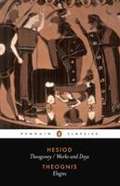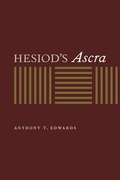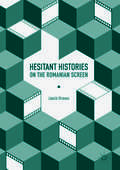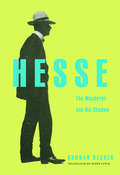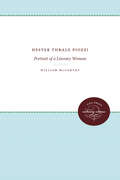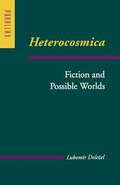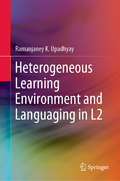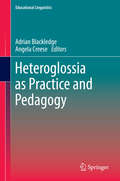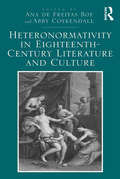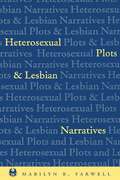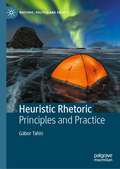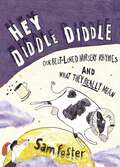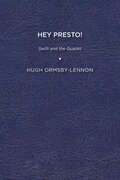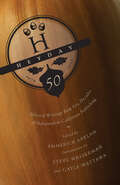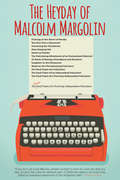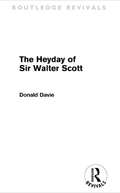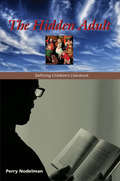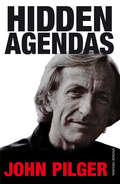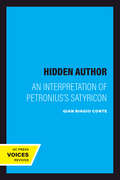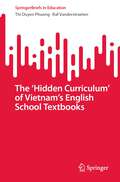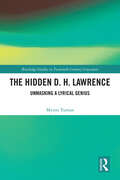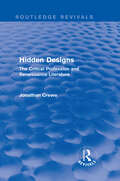- Table View
- List View
Hesiod and Theognis: Theogony, Works and Days, and Elegies
by Hesiod Theognis Dorothea WenderTogether these two poets-Hesiod, the epic poet, and Theognis, the elegist-offer a superb introduction to the life and thought of ancient Greece.
The Hesiodic Catalogue of Women and Archaic Greece
by Kirk OrmandThis book examines the extant fragments of the archaic Greek poem known in antiquity as Hesiod's Catalogue of Women. Kirk Ormand shows that the poem should be read intertextually with other hexameter poetry from the eighth to sixth century BCE, especially Homer, Hesiod, and the Cyclic epics. Through literary interaction with these poems, the Catalogue reflects political and social tensions in the archaic period regarding the production of elite status. In particular, Ormand argues that the Catalogue reacts against the "middling ideology" that came to the fore during the archaic period in Greece, championing traditional aristocratic modes of status. Ormand maintains that the poem's presentation of the end of the heroic age is a reflection of a declining emphasis on nobility of birth in the structures of authority in the emerging sixth century polis.
Hesiodic voices
by Richard HunterThis book selects central texts illustrating the literary reception of Hesiod's Works and Days in antiquity and considers how these moments were crucial in fashioning the idea of 'didactic literature'. A central chapter considers the development of ancient ideas about didactic poetry, relying not so much on explicit critical theory as on how Hesiod was read and used from the earliest period of reception onwards. Other chapters consider Hesiodic reception in the archaic poetry of Alcaeus and Simonides, in the classical prose of Plato, Xenophon and Isocrates, in the Aesopic tradition, and in the imperial prose of Dio Chrysostom and Lucian; there is also a groundbreaking study of Plutarch's extensive commentary on the Works and Days and an account of ancient ideas of Hesiod's linguistic style. This is a major and innovative contribution to the study of Hesiod's remarkable poem and to the Greek literary engagement with the past.
Hesiod's Ascra
by Anthony T. EdwardsAnthony T. Edwards extracts from Hesiod's poem "Works and Days" a picture of the social structure of Ascra, the hamlet in northern Greece where Hesiod lived, most likely during the seventh century B.C.E.
Hesitant Histories on the Romanian Screen
by László StrauszThis book argues that hesitation as an artistic and spectatorial strategy connects various screen media texts produced in post-war Romania. The chapters draw a historical connection between films made during the state socialist decades, televised broadcasts of the 1989 Romanian revolution, and films of the new Romanian cinema. The book explores how the critical attitude of new Romanian cinema demonstrates a refusal to accept limiting, binary discourses rooted in Cold War narratives. Strausz argues that hesitation becomes an attempt to overcome restrictive populist narratives of the past and present day. By employing a performative and mobile position, audiences are encouraged to consider conflicting approaches to history and social transformation.
Hesse: The Wanderer and His Shadow
by Gunnar DeckerAgainst Nazi dictatorship,the disillusionment of Weimar, and Christian austerity, Hermann Hesse’s stories inspired a nonconformist yearning for universal values to supplant fanaticism in all its guises. He reenters our world through Gunnar Decker’s biography—a champion of spiritual searching in the face of mass culture and the disenchanted life.
Hester Thrale Piozzi: Portrait of a Literary Woman
by William McCarthyMuch has been written about Thrale, friend and hostess of Samuel Johnson, but this is the first study to focus on Piozzi as the writer. In his narrative of her life, McCarthy draws on a large body of published and unpublished sources to map Piozzi's literary development, define her literary identity, and evaluate her achievement. In addition to reexamining her best-known works, he present the first serious treatment of her poetry, political works, and historical writings.Originally published in 1985.A UNC Press Enduring Edition -- UNC Press Enduring Editions use the latest in digital technology to make available again books from our distinguished backlist that were previously out of print. These editions are published unaltered from the original, and are presented in affordable paperback formats, bringing readers both historical and cultural value.
Heterocosmica: Fiction And Possible Worlds (Parallax: Re-visions Of Culture And Society)
by Lubomír Dolezel"The universe of possible worlds is constantly expanding and diversifying thanks to the incessant world-constructing activity of human minds and hands. Literary fiction is probably the most active experimental laboratory of the world-constructing enterprise."—from the author's Preface <P><P> The standard contrast between fiction and reality, notes Lubomír Dolezel, obscures an array of problems that have beset philosophers and literary critics for centuries. Commentators usually admit that fiction conveys some kind of truth—the truth of the story of Faust, for instance. They acknowledge that fiction usually bears some kind of relation to reality—for example, the London of Dickens. But both the status of the truth and the nature of the relationship have baffled, frustrated, or repelled a long line of thinkers. <P><P> In Heterocosmica, Lubomír Dolezel offers nothing less than a complete theory of literary fiction based on the idea of possible worlds. Beginning with a discussion of the extant semantics and pragmatics of fictionality—by Leibniz, Russell, Frege, Searle, Auerbach, and others—he relates them to literature, literary theory, and narratology. He also investigates theories of action, intention, and literary communication to develop a system of concepts that allows him to offer perceptive reinterpretations of a host of classical, modern, and postmodern fictional narratives—from Defoe through Dickens, Dostoevsky, Huysmans, Bely, and Kafka to Hemingway, Kundera, Rhys, Plenzdorf, and Coetzee. By careful attention to philosophical inquiry into possible worlds, especially Saul Kripke's and Jaakko Hintikka's, and through long familiarity with literary theory, Dolezel brings us an unprecedented examination of the notion of fictional worlds.
Heterogeneous Learning Environment and Languaging in L2 (Springerbriefs In Education Ser.)
by Ramanjaney K. UpadhyayThis book explores heterogeneity in the Indian academic setting. Presenting a study on the performance of Bachelor of Engineering students from various parts of the county, it analyzes the subjects’ language skills on the basis of selected sociolinguistic variables and examines the possible role/impact of using multiple languages in the communicative setting described. In turn, the book investigates the differences between the way language is viewed in the Orient and in the Western world, and how, despite their differences, these views lead to similar language teaching methods in both worlds. It also highlights the limitations of current theories and frameworks in terms of accommodating modern methods of assessing language skills. Addressing socio-pragmatic issues in terms of English proficiency and language assessment, it is the first book to offer such a focused and detailed discussion of these varied but related issues, making it a valuable resource for all scholars and researchers working in the areas of socio-pragmatics, language assessment, and intercultural communication.
Heteroglossia as Practice and Pedagogy
by Adrian Blackledge Angela CreeseThis volume presents evidence about how we understand communication in changing times, and proposes that such understandings may contribute to the development of pedagogy for teaching and learning. It expands current debates on multilingualism, asking which signs are in use and in action, and what are their social, political, and historical implications. The volume's starting-point is Bakhtin's 'heteroglossia', a key concept in understanding the tensions, conflicts, and multiple voices within, among, and between those signs. The chapters provide illuminating accounts of language practices as they bring into play, both in practice and in pedagogy, voices which index students' localities, social histories, circumstances, and identities. The book documents the performance of linguistic repertoires in an era of profound social change caused by the shifting nature of nation-states, increased movement of people across territories, and growing digital communication. "Our thinking on language and multilingualism is expanding rapidly. Up until recently we have tended to regard languages as bounded entities, and multilingualism has been understood as knowing more than one language. Working with the concept of heteroglossia, researchers are developing alternative perspectives that treat languages as sets of resources for expressing meaning that can be drawn on by speakers in communicatively productive ways in different contexts. These perspectives raise fundamental questions about the myriad of ways of knowing and using language(s). This collection brings together the contributions of many of the key researchers in the field. It will provide an authoritative reference point for contemporary interpretations of 'heteroglossia' and valuable accounts of how 'translanguaging' can be explored and exploited in the fields of education and cultural studies. " Professor Constant Leung, King's College London, UK. "From rap and hip hop to taxi cabs, and from classrooms to interactive online learning environments, each of the chapters in this volume written by well-known and up-and-coming scholars provide fascinating accounts drawing on a wide diversity of rich descriptive data collected in heteroglossic contexts around the globe. Creese and Blackledge have brought together a compelling collection that builds upon and expands Bakhtin's construct of heteroglossia. These scholars help to move the field away from the view of languages as separate bounded system by providing detailed examples and expert analyses of the ways bilinguals and multilinguals draw upon their linguistic repertoires for effective and meaningful communication. " Wayne E. Wright, University of Texas at San Antonio, USA.
Heteronormativity in Eighteenth-Century Literature and Culture
by Ana de Boe Abby CoykendallThe resurgence of marriage as a transnational institution, same-sex or otherwise, draws upon as much as it departs from enlightenment ideologies of sex, gender, and sexuality which this collection aims to investigate, interrogate, and conceptualize anew. Coming to terms with heteronormativity is imperative for appreciating the literature and culture of the eighteenth century writ large, as well as the myriad imaginaries of sex and sexuality that the period bequeaths to the present. This collection foregrounds British, European, and, to a lesser extent, transatlantic heteronormativities in order to pose vital if vexing questions about the degree of continuity subsisting between heteronormativities of the past and present, questions compounded by the aura of transhistoricity lying at the heart of heteronormativity as an ideology. Contributors attend to the fissures and failures of heteronormativity even as they stress the resilience of its hegemony: reconfiguring our sense of how gender and sexuality came to be mapped onto space; how public and private spheres were carved up, or gendered and sexual bodies socially sanctioned; and finally how literary traditions, scholarly criticisms, and pedagogical practices have served to buttress or contest the legacy of heteronormativity.
Heterosexual Plots and Lesbian Narratives (The Cutting Edge: Lesbian Life and Literature Series)
by Marilyn FarwellWhat is lesbian literature? Must it contain overtly lesbian characters, and portray them in a positive light? Must the author be overtly (or covertly) lesbian? Does there have to be a lesbian theme and must it be politically acceptable? Marilyn Farwell here examines the work of such writers as Adrienne Rich, Marion Zimmer Bradley, Jeanette Winterson, Gloria Naylor, and Marilyn Hacker to address these questions. Dividing their writings into two genres--the romantic story and the heroic, or quest, story, Farwell addresses some of the most problematic issues at the intersection of literature, sex, gender, and postmodernism. Illustrating how the generational conflict between the lesbian- feminists of twenty years ago and the queer theorists of today stokes the critical fires of contemporary lesbian and literary theory, Heterosexual Plots and Lesbian Narratives concludes by arguing for a broad and generous definition of lesbian writing.
Heuristic Rhetoric: Principles and Practice (Rhetoric, Politics and Society)
by Gábor TahinThis book introduces a novel approach to the analysis and practice of persuasive speaking and writing: heuristic rhetoric. The new method has evolved to fulfil the need at universities, government departments, political organisations, business enterprises and other public institutions for a modern practical alternative to classical rhetoric, which is, in the author’s view, no longer capable of giving a complete description of contemporary, predominantly mediatised, forms of public persuasive discourse, whilst other competing disciplines, such as critical discourse analysis or strategic manoeuvring, have not yet produced a set of tools, which have the comprehensive nature and practical orientation of Classical Greek and Roman rhetorical system. The book expounds heuristic rhetoric as an inter-disciplinary method to develop advanced skills of critical and strategic reasoning. Applying a novel set of principles for the strategic analysis of persuasive reasoning in complex rhetorical situations, the method emphasizes preparing and continuously adjusting argumentation according to the demands of unpredictable circumstances.
Hey Diddle Diddle: Our Best-Loved Nursery Rhymes and What They Really Mean
by Sam FosterThis charming compilation of 40 of the best-loved traditional nursery rhymes offers clues as to their true meanings and often surprising origins. Many were not nonsense verses for the playground but served as satirical commentaries on political events of the day. This humorously illustrated book offers a fascinating trip down memory lane.
Hey Diddle Diddle: Our Best-Loved Nursery Rhymes and What They Really Mean
by Sam FosterThis charming compilation of 40 of the best-loved traditional nursery rhymes offers clues as to their true meanings and often surprising origins. Many were not nonsense verses for the playground but served as satirical commentaries on political events of the day. This humorously illustrated book offers a fascinating trip down memory lane.
Hey Presto!: Swift and the Quacks
by Hugh Ormsby-LennonIn this book the author reveals how medicine shows, both ancient and modern, galvanized Jonathan Swift’s imagination and inspired his wittiest satiric voices. Swift dubbed these multifaceted traveling entertainments his Stage-itinerant or “Mountebank’s Stage.” In the course of arguing that the stage-itinerant formed an irresistible model for A Tale of a Tub, Ormsby-Lennon also surmises that the mountebank’s stage will disclose that missing link, long sought, which connects the twin objects of Swift’s ire: gross corruptions in both religion and learning. In the early modern medicine show, the quack doctor delivered a loquacious harangue, infused with magico-mysticism and pseudoscience, high-astounding promises, and boastful narcissism. To help him sell his panaceas and snake-oil, he employed a Merry Andrew and a motley troupe of performers. From their stages, many quacks also peddled their own books, almanacs, and other ephemera, providing Grub Street with many of its best-sellers. Hacks practiced, quite literally, as quacks. Merry Andrew and mountebank traded costumes, whiskers, and voices. Swift apes them all in the Tale. Published by University of Delaware Press. Distributed worldwide by Rutgers University Press.
Heyday at Fifty: Selected Writings from Five Decades of Independent California Publishing
by Emmerich AnklamA polyphonic celebration of a preeminent California publisher, featuring over 35 pieces drawn from across Heyday's distinguished history."Confluence is a big part of California, and Heyday has been the glorious secret center of confluence for many years, the place where art and literature and Native lore and environmental history all converge." —Rebecca SolnitSince its founding in 1974, Heyday—an independent nonprofit based in Berkeley—has published more than 500 books that have shaped California's deepest, most abiding sense of itself. Heyday now gathers three dozen highlights drawn from half a century of distinguished publishing, featuring writing by the likes of Deborah A. Miranda, Gary Snyder, Jane Smiley, Linda Ronstadt, John Muir Laws, Obi Kaufmann, and founder Malcolm Margolin. Taken together, these pieces embody Heyday's guiding ethos: to celebrate the natural wonders of the Golden State, to explore California's vibrant arts and history, to amplify the voices of the West's Indigenous peoples, and to foster civic engagement and social justice. Edited by Emmerich Anklam, and featuring an introduction by publisher Steve Wasserman and general manager Gayle Wattawa, Heyday at Fifty serves as a testament to Heyday's preeminent place in California letters.
The Heyday of Malcolm Margolin: The Damn Good Times of a Fiercely Independent Publisher
by Kim BancroftIn an age of big box stores and media conglomerates, how can an independent publishing house survive—and even thrive? Kim Bancroft takes us into Heyday, a small press that for forty years has spotlighted California's best stories. Drawing from the words of founder Malcolm Margolin, this compelling portrait recounts the making of Heyday, from its roots in the do-it-yourself/change-the-world clime of 1970s Berkeley to its present-day status as the “cultural linchpin for the state” (Northern California Book Booksellers Association). A chorus of friends, including Maxine Hong Kingston, Robert Hass, and Kevin Starr, enriches our understanding of a vibrant literary community and its one-of-a-kind leader. Funny and provocative, The Heyday of Malcolm Margolin reveals the workings of a courageously unconventional enterprise run on beauty, passion, friendship, and joy.
The Heyday of Sir Walter Scott (Routledge Revivals)
by Donald DavieFirst published in 1961, this book examines a number of works popular in the Romantic period, during the heyday of Sir Walter Scott in the early part of the nineteenth century. Encompassing works by the likes of Alexander Pushkin, Sir Walter Scott, Adam Mickiewicz and James Fenimore Cooper, this is also a meditation on the nature of Romanticism and its enduring value, as expressed in the novel form. Donald Davie also considers the meaning and importance of ‘plot’ and of ‘realism’.
The Hidden Adult: Defining Children's Literature
by Perry NodelmanWhat exactly is a children’s book? How is children’s literature defined as a genre? A leading scholar presents close readings of six classic stories to answer these questions and offer a clear definition of children’s writing as a distinct literary form. Perry Nodelman begins by considering the plots, themes, and structures of six works: "The Purple Jar," Alice in Wonderland, Dr. Doolittle, Henry Huggins, The Snowy Day, and Plain City—all written for young people of varying ages in different times and places—to identify shared characteristics. He points out markers in each work that allow the adult reader to understand it as a children’s story, shedding light on ingrained adult assumptions and revealing the ways in which adult knowledge and experience remain hidden in apparently simple and innocent texts.Nodelman then engages a wide range of views of children's literature from authors, literary critics, cultural theorists, and specialists in education and information sciences. Through this informed dialogue, Nodelman develops a comprehensive theory of children's literature, exploring its commonalities and shared themes. The Hidden Adult is a focused and sophisticated analysis of children’s literature and a major contribution to the theory and criticism of the genre.
Hidden Agendas
by John PilgerIn this powerful book, journalist and film maker John Pilger strips away the layers of deception, dissembling language and omission that prevent us from understanding how the world really works. From the invisible corners of Tony Blair's Britain to Burma, Vietnam, Australia, South Africa and the illusions of the 'media age', power, he argues, has its own agenda. Unchallenged, it operates to protect its interests with a cynical disregard for people - shaping, and often devastating, millions of lives. By unravelling the hidden histories of contemporary events, Pilger allows us to read between the lines. He also celebrates the eloquent defiance and courage of those who resist oppression and give us hope for the future. Tenaciously researched and written with passion and wit, Hidden Agendas will change the way you see the world.
The Hidden Author: An Interpretation of Petronius's Satyricon (Sather Classical Lectures #60)
by Gian Biagio ConteThe Satyricon of Petronius, a comic novel written in the first century A.D., is famous today primarily for its amazing banquet tale, "Trimalchio's Feast." But this episode is only one part of the larger picture of life during Nero's rule presented in the work. In this accessible discussion of Petronius's masterful use of parody, Gian Biagio Conte offers an interpretation of the Satyricon as a whole. He combines the scholarly precision of close reading with a significant, original theoretical model.At the heart of his interpretation, Conte reveals the technique of the "hidden author" that Petronius employs at the expense of his characters, in particular the teller of the story, Enclopius. By remaining hidden outside the narrative, Petronius invites the reader to smile at the folies de grandeur that occur in a culture of scholars and declaimers. Yet as Conte shows, behind the parody and inexhaustible humor of the Satyricon lies an unexpectedly serious lament. For those familiar with the Satyricon, as well as for new readers, Conte's book will be a reliable, enjoyable guide to the wonders the Satyricon contains.
The ‘Hidden Curriculum’ of Vietnam’s English School Textbooks (SpringerBriefs in Education)
by Thi Duyen Phuong Raf VanderstraetenThis book analyzes the basic ideas and premises underlying the English textbooks used at the higher secondary school level in Vietnam from the 1980s to the present, from a sociological perspective. The dataset, upon which this book builds, consists of a collection of 18 textbooks, which belong to five sets of locally developed English textbooks for grade 10 to grade 12 students. These series were used in all public schools from the mid-1980s to the present. During this period, schooling expanded rapidly in Vietnam, while English also gained increasing prominence within the school system.This book examines the curricular content of these textbooks and presents a long-term analysis of the ‘hidden’ curricular content in light of Vietnam’s recent history and its government’s concerns about national identity.
The Hidden D. H. Lawrence: Unmasking a Lyrical Genius (Routledge Studies in Twentieth-Century Literature)
by Myron TumanThe Hidden D. H. Lawrence is a new study of the psychological and literary aspects of a great writer’s lyrical genius. It explores how Lawrence, when writing on his favorite subject, the relations between men and women, moved so quickly between heavy-handed exposition and deeply inspired prose, depending on the gender of the object of his attention. Nowhere is this clearer than in the three grand love scenes from Lady Chatterley’s Lover, those cut from the first American edition of 1932. In these scenes, Mellors, Lawrence’s usual alter ego, suddenly and almost magically becomes the object of attention, although now seen through the eyes of his female protagonist. It may seem as if Lawrence’s purpose here is to probe a woman’s psyche, until one realizes that it is only such moments—when his focus seems less on his female character than the erotic allure of a powerful man—that unlock Lawrence’s lyrical genius. The claim here is that in his major novels and stories, Lawrence was less interested in exploring the emotional lives of women than in using his female characters (as well as many sensitive male protagonists) to explore his own psychic life, one marked by the persistent attraction to the image of a strong male—an inner life that for the last century has been hiding in plain sight.
Hidden Designs: The Critical Profession and Renaissance Literature (Routledge Revivals)
by Jonathan CreweThis 1986 study offers a challenging contribution to the on-going critical debate surrounding the English literary Renaissance. Although informed by the ‘new historicism’ and post-structuralism, Hidden Designs makes a plea for criticism to be practiced in its own name rather than in the name of theory, and opposes the hyper-professionalisation of literary studies in favour of the broader communal functions of criticism. Major Renaissance authors and their recent critics are placed under ‘suspicion’ as Crewe explores the elements of ‘criminality’ inherent in the powerful interests –personal, institutional, political and cultural – served by the literary enterprise, or channelled through it. Revisionary readings of Sidney, Spenser, Puttenham and Shakespeare are linked by a continuing commentary on the history and theoretical claims of Renaissance criticism.
